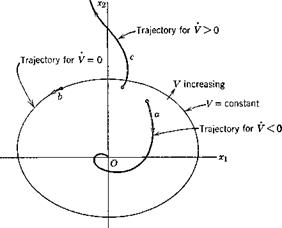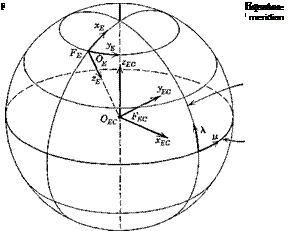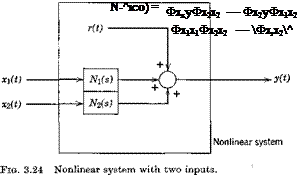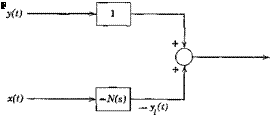The second general method for treating nonlinear systems is Lyapunov’s theory.
The stability of linear/invariant systems was shown in Sec. 3.3 to be completely determined by the eigenvalues, and certain criteria were presented that could be applied to the characteristic equation to predict the stability properties of the roots. In that case we may say that we have investigated the stability by studying the properties of the solutions. This is possible of course only because we have an adequate theory for the solutions. For more general systems, this approach may not be possible since the solutions are not in general known. A method of treating the stability of equilibrium for any system, which does not require a knowledge of the solutions, has been given by Lyapunov (refs. 3.2, 3.8). We present below a brief outline of the main concepts but refer the reader to refs. 3.2 and 3.8 for a fuller treatment and for the methods of finding the appropriate Lyapunov functions.
We begin with a simple analogy by considering a ball at the bottom of a cup of arbitrary shape. The bottom is a position of stable equilibrium with respect to all disturbances small enough that the ball is not projected over the rim. This stable condition can be viewed from the standpoint of the
total energy E of the ball. If E is less than the potential energy ECIlt associated with the height of the lowest point on the rim, then escape is impossible, and the system is stable. Note that the lowest point in the cup is a point of minimum potential energy, and that the minimum of E corresponds to equilibrium there. In any real case, there will be frictional dissipation, so that Ё is negative whenever there is motion, and if the ball is started anywhere in the cup with E < ECIit, it will eventually come to rest at the bottom.
The Lyapunov theory is basically nothing more than a generalization of the above concept, and indeed for some physical systems, the energy itself is a suitable Lyapunov function. More generally, a Lyapunov function F(aq • • • xn) is any positive definite function of all the state variables x{ that is zero at the origin (an equilibrium state) and that increases monotonically within a region 3% of state space as one proceeds along the vector grad V = VV, i. e. it is a “cup-shaped” function with its “bottom” at the equilibrium point the stability of which is to be investigated. The critical question is whether V is positive, negative or zero in M. If positive, the state point “climbs up the V hill” proceeding ever farther from the origin, indicating instability. If negative, the state point descends continuously until it comes to rest at the origin, and the system is asymptotically stable. If V = 0, then the only motion possible is an orbital trajectory in which the state point remains on the surface V = const. These cases are illustrated in Fig. 3.25 for a two-dimensional state space. The essence of the problem is of course to find a suitable V function. Ideally one wants that function that gives the exact stability boundary in state space. This ideal is not usually achieved
|

Fig. 3.25 Trajectories in state space.
|
for other than linear/invariant systems, or simple mechanical ones such as the ball in the cup.
The great advantage of this approach is that V can be calculated directly from the differential equations, no solutions of them being needed. Let the equations be given
Since both V and/are known У can be calculated directly, and the stabihty properties inferred from how its sign varies with position in state space.
The main disadvantage of the Lyapunov approach is that the functions V are to a certain extent arbitrary, and hence can in most cases only provide a conservative estimate of stability. For example, if it is found that the limit of the monotonically increasing V for negative V is a certain surface 8 in state space, then it can be said that the system is stable for disturbances sufficiently small that the initial state point lies within S, but it is not known whether it may be stable beyond 8, since a different V function might have produced a larger domain of stability. It should be pointed out that for some problems in mechanics, as distinct from control systems (which have been the principal object of applications of Lyapunov theory) the Hamiltonian of the system can be a useful Lyapunov function (see Pringle, ref. 3.11).
The previous discussion has related to the stability of an equilibrium point (the origin in state space). However there are many important situations in the flight of aircraft and spacecraft when there is no steady state, as in the take-off and landing of aircraft, and the launch and reentry of spacecraft. If the state vector in such transient situations changes “slowly” with time (what constitutes “slowness” must be determined in each case), then a point-by-point stability analysis may be useful. In that case, each point on the trajectory is treated as a constant reference state (equilibrium) and the stabihty of disturbances from it is investigated in the manner discussed
above. When the transient is “rapid,” i. e. when the characteristic times (e. g. periods and damping times) of the disturbance motions are long enough that large changes can occur in the reference transient during these time intervals, then the “quasi-steady” analysis may be meaningless. In this case the stability analysis of the transient can be transformed into that of an equilibrium point as explained on p. 50, and the Lyapunov analysis for equilibrium again applied.
A general comment about the usefulness of stability analysis in aerospace systems is in order. It is a fact that stability is neither a necessary nor a sufficient condition for the successful performance of aerospace missions. A stable airplane may have unsatisfactory handling qualities, and vice versa; and an unstable flight path for a lifting entry vehicle may be perfectly acceptable within the tolerances on initial conditions that are practically available. Thus the determination of stability boundaries of nonlinear and time-varying systems does not appear to be an objective to which a great deal of effort should be applied. Of more direct import are appropriate performance criteria. These may take many forms depending on the vehicle and mission—for example, pilot rating in aircraft and terminal errors for reentry vehicles.











 Fig. 4.3 The local (FE) and vehicle-carried (Fy) vertical reference frames.
Fig. 4.3 The local (FE) and vehicle-carried (Fy) vertical reference frames.



